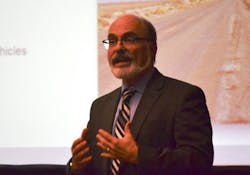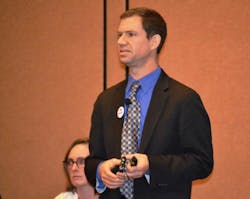LAS VEGAS. A high-ranking official with the Federal Motor Carrier Safety Administration opened his presentation here by assuring fleet executives that “we don’t just make things up” and that the “vast majority” of the agency’s rulemakings are mandated by Congress. Indeed, the FAST Act—the five-year highway bill enacted last December—calls for 20 rulemakings, explained Jack Van Steenburg, chief safety officer and assistant administrator for FMCSA.
And the federal rulemaking process—notices of proposed rules, cost-benefit calculations, public comment periods, extensive reviews—are there to protect the public from “over-zealous” regulation. In short, “there shouldn’t be any surprise” when a new rule is developed, he emphasized.
Van Steenburg led off the 2016 ATA Management Conference and Exhibition session, “More regulations: What you should expect next, when and why,” before yielding the floor to trucking industry representatives who followed up with explanations of new regulations coming from National Highway Traffic Safety Administration, the Environmental Protection Agency, the Occupational Safety and Health Administration, and the Pipeline and the Hazardous Materials Safety Administration.
And the number and scope of the new and pending rules might prompt truckers to wonder just how successful those protections from over-zealous federal regulators truly are, and instead to side with ATA President and CEO Chris Spear who earlier in the annual meeting faulted regulators who “issue mandates as if they were mere parking tickets.”
Regardless, here’s a rundown of what’s on tap from Washington:
Speed limiters for trucks
While the joint rulemaking from FMCSA and NHTSA proposes three speed alternatives, “there are other considerations out there,” Van Steenburg said. “This is not a done deal folks.”
FMCSA expects a lot comment on the rule, and acknowledges the speed differentials between commercial vehicles and passenger cars will get much of the attention.
“Twenty-two percent of the large-truck drivers that are killed in crashes are speeding,” he said. “We really need to reduce that.”
The rule is currently open for public comment, with both ATA and the Owner-Operator Independent Drivers Assn. asking for extensions.
Electronic logging devices
“This is a big, big rule,” Van Steenburg said, before explaining the December 2017 deadline.
He also discussed the self-certification process, and suggested that while many of the biggest names in e-log services have to put themselves on the list of certified providers, he expects them to be on it soon. And many will be able to do with only software changes to current systems.
FMCSA also will be taking down some of the test scenarios included in the self-certification process because those test pertain to Web Services—and the agency is not yet ready with its part of the system. FMCSA will also clarify how a provider can still self-certify, even before Web Services is up and running.
“We will have Web Services and e-RODS in probably six to seven months,” he said. FMCSA will also host two additional webinars to explain the transition.
Drug and alcohol clearinghouse
The rule is currently under review at the White House Office of Management and Budget (OMB), and “it’s going to be a winner for the industry” by allowing carriers to access a single federal database to find out if a truck driver has a previous drug or alcohol incident on his or her record.
“It really prevents job hopping,” he said. “It’s a tool for all of us.”
Entry-level driver training
Also at OMB, the negotiated rulemaking to set federal driver training standards will have a three-year phase-in period, and Van Steenburg expects it to be out by the end of the year.
Windshield-mounted safety technology
“All of that equipment we’ve exempted over the years is in the rule and is permanent now,” Van Steenburg said, adding that while the rule specifies a number of technologies that are approved, “there are a couple that are gray areas.”
He named “fleet-related incident management systems” and “performance and behavior management systems” as items specified by Congress, but not exactly specific as to what the terms mean.
“Obviously, we’re going to give a lot of discretion to the carriers to install that,” he said, then noted that the real question is whether or not the devices need to be installed on the windshield.
Stability mandate
The rule, published in 2015, requires electronic stability control (ESC) systems on large trucks and buses beginning in 2017. The first phase begins Aug. 1, explained Fred Andersky, director of government and industry affairs for Bendix Commercial Vehicle Systems.
Six-by-four tractors built after Aug. 1 will be required to have full stability control, as opposed to simple roll stability systems. Class 8 motorcoaches will be required to have the technology in June 2018, and remaining tractors and Class 7 trucks will come under the mandate in August 2019.
Single unit trucks will not be required to have full stability systems, he added.
Collision mitigation
Safety groups petitioned NHTSA petitioned for a rulemaking on collision mitigation technology last year, and the National Transportation Safety Board has also called for the technology to be made standard on commercial vehicles.
Dubbed forward collision avoidance and mitigation braking systems or “F-CAM” systems, such technology should be able to brake on stationary vehicles, rapidly reduce closing speed, have a low rate of false alerts and interventions, and meet or exceed the European mandate for the equipment.
Andersky pointed out that NHTSA recently completed on real-world study on collision mitigation systems, finding that the technology was effective in reducing rear-end collisions, but that there was high level of false alerts on stationary objects, such as overhead signs or guard rails.
The agency will conduct an additional study using newer technologies designed specifically to better handle braking on stationary objects.
“NHTSA may come out with a Notice of Proposed Rulemaking in 2017, but I think it’s more likely to be 2018,” Andersky said. “Depending on how the election goes, it could all change after November. There could be a big difference in terms of rulemaking as we move forward.”
Autonomous vehicles
Noting that “rulemakings take time,” Andersky explained the DOT’s recently announced policy on autonomous vehicles sets the government up to develop “flexible and nimble” guidance.
“They know that the technology is going to keep evolving,” he said. “A rulemaking is too slow to keep up. Is it a hard and fast rule? No. Does it have the teeth of a regulation? NHTSA can, if it’s an imminent hazard, have a recall whether or not there is a FMVSS being violated. That’s going to be an interesting one to see how that plays out.”
Andersky noted that it won’t be just the companies that manufacture the technology that will fall under the guidance. Others using Level 2 autonomous systems—such as Peloton, which uses such systems in a platooning system, and OTTO, which is developing self-driving trucks—will be regulated as well.
“In a nutshell, really, right now this has more impact on suppliers,” Andersky said. “For fleets, this means being able to take a look and evaluate the technology. Some of these systems can be retrofittable. In which case, test it in your new trucks first and make sure it’s going to work and can manage the situation, because if you put this technology in all of your trucks and NHTSA decides to have a recall, you could have some issues.”
Fuel efficiency standards
Following up on the “win-win” Phase 1 truck fuel efficiency/greenhouse gas emissions standards, the Phase2 goals are specific and challenging but the rule is flexible enough that truck and engine makers will be able to meet them without disruption, explained Sean Waters, director of compliance and regulatory affairs for Daimler Trucks North America.
“We picked low-hanging fruit first, the quick, easy wins for our customers,” Waters said, referring to the 2010 standards. “This is a much tougher rule. We’ll have to spend hundreds of millions of dollars in R&D to hit the targets, but we’re confident we can hit those targets in a way that will still provide benefits for our customers. If the technology saves the customer money at the end of the day, then they’re going to buy it and we’ll see environmental benefits as well as fuel economy benefits.”
He pointed out that “a whole suite of technologies” will be available, and customers will decide which best fit their operations, rather than being forced to adopt systems that don’t match their needs.
Why?
Waters also briefly discussed the possibility of doing away with regulations that no longer serve their original purpose. He cited specifically the ongoing attempt to allow camera systems to replace side mirrors, technology designed to improve both safety and truck aerodynamics.
“It’s very hard to get the government to get rid of regulations,” he said. “Are people going to buy [the cameras] tomorrow or a week from tomorrow? No. But the technology that exists today can provide a real safety benefit that we’re not allowed to put on our trucks because of a FMVSS requirement.”
He also questioned the need for marker lights on the top of trucks—and added that research has yet to find what the original justification for the 1930s rule was.
So Waters is taking a “comprehensive look” at the truck regulations to determine which make sense and which no longer do. He hopes to develop a petition that makes the case for eliminating the unnecessary rules, and asked those in attendance to participate “to see if we can’t clean up some of the regulations and get them to align with our modern technology.”
Beyond regulations
“It’s very easy to regulate the heavy-duty trucking industry,” Waters said. “We’re easy to find. NHTSA and EPA know how to regulate us. We’re not afraid to do our part and improve the truck. But there’s more to be done.”
Waters then posted a slide showing that more than 2.2 billion gallons of fuel are projected to be saved annually by GHG Phase 2—but more than 3 billion gallons are wasted due to congestion.
“We obviously have to have increased spending on infrastructure, and now is the time,” he concluded. “For all of the great new technology we put on our trucks, it doesn’t get any better fuel economy if it’s just sitting in traffic, stuck. This is an area we can, should, and must improve.”






